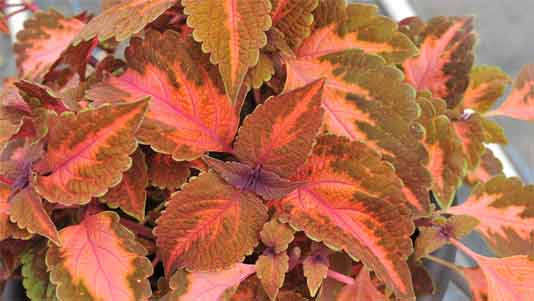How to Grow Coleus
Fantastic foliage brings bursts of color to shady spots

Garden designers know that when it comes to annuals, it's not just about the flowers — foliage matters, too. And when it comes to foliage, coleus tops the list. From bold burgundy to lime green to a warm chestnut, coleus comes in a rainbow of colors. Coleus can be grouped into three plant forms: upright, rounded, and trailing. Frequent snipping, pinching and trimming can help modify form although the trailing varieties have great value at the edge of a planter or in a hanging basket.

How to Grow Coleus From Seed
Raising coleus from seed is relatively easy:
- Sow seeds 8-12 weeks before the last frost date in your area.
- Because seeds require light to germinate, sow them on the surface and use grow lights to provide adequate light. Seeds will germinate in 10-14 days.
- Cover seeds with a humidity dome, but once seeds have germinated, remove the cover so air can circulate among seedlings. For best results, use a seed starting system that will allow plants to be watered from the bottom up.
- Plant coleus after danger of frost has passed when soil temperatures have warmed sufficiently and evening temperatures are above 60 degrees F.
 Get a dramatic effect in your beds and borderds by planting a single variety en masse, such as 'Redhead', shown here. Photo: Steve Foltz
Get a dramatic effect in your beds and borderds by planting a single variety en masse, such as 'Redhead', shown here. Photo: Steve Foltz
How to Plant and Care for Coleus
Soil
Coleus prefers consistently moist, rich, loose, well-draining soil. Avoid overly damp soils, which can cause leaf drop and encourage disease. Before planting, amend the soil with compost.
Container-grown coleus loves loose, fertile, potting soil. Start with a quality potting mix with a slightly acidic to neutral pH of 6.0 to 7.0. Be sure that your container has adequate drainage holes to ensure the soil isn't constantly wet, which can lead to root rot. Feed plants regularly with a water-soluble fertilizer, especially if they are growing in containers.
Light
Coleus has long been considered a shade plant, however some newer types have been bred to tolerate sun as long as they are not allowed to dry out. Too much harsh sun can scorch leaves and cause color to fade. Coleus seems to do best in bright morning sun, with some afternoon shade.
Pruning
To maintain plant form, pinch back every few weeks to prevent flower formation. Pinch just above a set of leaves or branching junction for the best appearance; don't leave a stub. Some gardeners leave the small flowers, but it's best to pinch them off to direct more energy into stem and foliage growth. Coleus left to flower may lose vigor as the plant puts energy into seed production.
Types of Coleus
When breeders try to create new plants, the focus is often on new color combinations. In recent years, other considerations have become prominent, too:
 ColorBlaze 'Sedona' thrives in shade or part sun.
ColorBlaze 'Sedona' thrives in shade or part sun.- sun-tolerance
- delayed flowering
- more prolific branching
- special growth habits, such as compact and trailing
ColorBlaze series: Upright plants grow 24-30 inches tall thrive in either shade or part sun.
Kong series: Large, vigorous plants that grow up to 2 feet tall and rock leaves up to 6 inches wide! This series does best in shade — too much sun will burn large leaves.
Premium Sun series: It's in the name — this series can tolerate sun or shade equally well. Plants are typically 20-30 inches tall and put out loads of foliage in contrasting shades of burgundy and lime green. Their mounding form make them excellent in borders, beds, and along walkways.
Superfine Rainbow series: Available in a range of variegated shades of maroon, cherry, rose, copper, and salmon, this series was bred specifically to flower later in the season — meaning plants pump out more foliage and stay tidy-looking. These plants are generally 12-14 inches tall and do best in shade.
Wizard series: Smaller, branching form of tidy-looking coleus that grow best in part sun. Growing just about 12 inches tall, this series is perfect for container plantings and hanging baskets.
Growing Coleus in Containers
Coleus do well in pots and planters, as long as they are planted in free-draining potting soil, fertilized regularly and given the right amount of sun. Avoid windy locations because coleus can be prone to breakage. Feed regularly during the growing season, following the rate recommended on the package. Coleus do not show their best color if over-fertilized, so be conservative and consistent. You may want to consider self-watering planters, especially in sunny locations.
Coleus can be included in hanging baskets, too. Some of the trailing selections will flow nicely over the edge. Compact, bushy types can be used in the center of the basket. Keep in mind that coleus are thirsty and a hanging basket can dry out quickly — choose a self-watering basket for best results.
 'Burgundy Wedding Train' is a trailing form, making it good for hanging baskets.
'Burgundy Wedding Train' is a trailing form, making it good for hanging baskets.
Print this Article:
Get the Dirt
Stay up to date on new articles and advice. Please fill out the information below.
